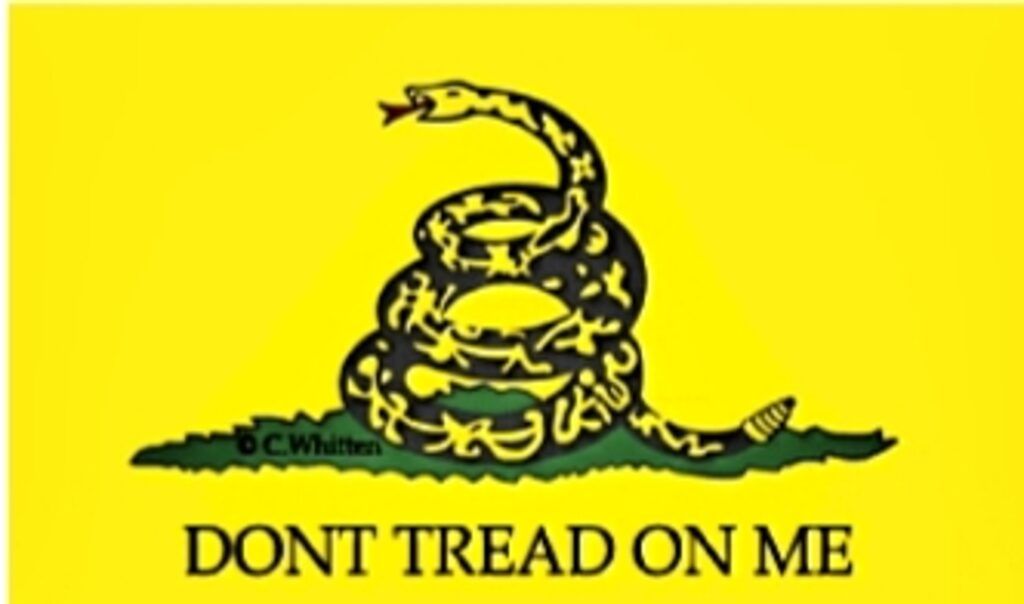The Gadsden Flag has its origins in the French and Indian War, the North American adjunct of the European Seven Years War. In this conflict, a young Virginia Militia Commander named George Washington fought side by side with British General Edward Braddock against the French. But colonists were largely indifferent to British squabbles. Philadelphia newspaperman Benjamin Franklin exhorted the colonies to join the fight or die – with a clever woodcut drawing of snake to make his point.
The European Seven Years War brought North American colonial frontier issues to a boil and Great Britain had to commit significant resources to protect its interests here. General Edward Braddock was dispatched from London to Virginia with two regiments of British Regulars in 1755, where he was supposed to hook up with colonial militiamen and receive logistical and administrative support to coordinate an attack on French forces at Fort Duquesne and the forks of the Ohio River.
Six colonial governors met with General Braddock and assured him of colonial resources and support, which assurances proved to be largely insincere and overblown. Internal divisions among Militia commanders, extremely poor management and coordination, lack of communication and widespread Colonial apathy to “English Affairs” convinced Braddock that he couldn’t rely on Colonials at all. Additional British Regulars – “Redcoats” – were imported and deployed (at great expense to the Crown) and, eventually, matters stabilized.
English attitudes about what they considered widespread tepid colonial devotion to His Majesty were hatched at this time. More importantly, British distain of colonial militia units was institutionalized – and would color future events in 1776. English dogma that colonials weren’t worth a tinkers’ damn in military campaigns would haunt George Washington (later, General Washington) in the years to come and throughout the Revolutionary War.
Around 1754 a newspaperman in Philadelphia was horrified by the inadequate performance of his militia “countrymen”. Benjamin Franklin distributed a series of monographs and pamphlets arguing why the British deserved colonial support from all of its children in the New World to defend against the French menace. He accompanied his writing with a now famous “woodcut” sketch of a timber rattlesnake cut into eight pieces, each piece bearing the initials of a (disinterested) seaboard colony – South Carolina, North Carolina, New Jersey, New York, New England, etc. Under this coiled-but-dismembered rattlesnake was the ominous banner: Join or Die!
Ever a student of the “Natural Sciences”, the multi-talented Franklin was channeling (tongue-in-cheek) an old wives’ tale and superstition that if someone cut a rattlesnake into pieces, thereby killing it, the snake could be brought back to life again by reconnecting each severed section before sunset.
Franklin’s message was simple: in this war against the French, the individual colonies are as the dead, severed rattlesnake – but reconnect its dangerous pieces and the snake can be reborn as a deadly and capable adversary. His woodcut was a satirical but fervent plea for unity at a time of peril from the French. This snake motif would be dusted off in 1776 when colonists united against their motherland, England.
Late in life, Benjamin Franklin commented that he came upon the idea while contemplating the timber rattlesnake’s character. He thought it was a good symbol of the american spirit. Slow to anger, always giving a loud warning to its perceived aggressor before it struck, generally peaceable unless roused. Franklin thought these traits honorable and meritorious.
Clearly, in this now-famous woodcut Ben Franklin was admonishing his fellow colonists to fight for themselves – that their unity could make a difference in a war that was threatening (if not their sea coasts) their frontier. Coastal colonies, however, were not impressed. England eventually funded and fought most of the North American battles of the French and Indian War until its end in 1763, when the European conflict ended. The Treaty of Paris (1763) vastly curtailed most French possessions in North America and the British Colonial frontiers were finally secured.
England was once more at peace – but heavily in debt from financing ten years of unremitting land and naval warfare. Why not, Parliament asked, make the colonists pay their fair share of the tab? After all, they now enjoyed their colonial hinterlands and freedom of the seas for trade because England vanquished the French threat from their shores. New taxes and levies were announced. A “Stamp Act” for all official documents, taxes on tea, tobacco and rum were now expected to be paid by the american colonies to help make good England’s military costs. As the “New World” prospered, England felt justified in exacting their share of colonial good fortune.
Of course, the colonies were apoplectic when they learned of England’s plans. Their purse, they believed, was none of the King’s business.
The American Revolution was born. As events gained momentum, Colonists issued their famous Declaration of Independence in 1776. General George Washington was tasked with leading a Continental Army to victory against the British tyrant, King George III.
Most objective US historians today concede – albeit reluctantly – that the Brits had a point. The Ports of Boston and New York were doing tremendous business. Trading, fishing, manufacturing of all kinds, tobacco and cotton cultivation in the South – the Colonies were making money hand over fist. But when it came to forking some of that bounty over to pay for their frontier and sea-lane defense, they balked. Let the “Motherland” handle it, they whined. “It’s not our problem” was their general sentiment.
Historians often quote a member of the British House of Commons at the time, Charles Townshend (1765), that colonists were “children planted by our care, nourished by our indulgence”. His Majesty insisted the Colonies were in his debt – and it was time for England to settle accounts.
The central conundrum was simple – war is expensive. Ironically, to pay for its own astronomical War of Independence debts, the nascent United States explored all kinds of financing options: taxing liquor (which led to the Whiskey Rebellion of 1791), reneging on paying wages, pensions and land grants in the Ohio frontier to Continental soldiers who served their full terms (which led to Shay’s Rebellion of 1787). Forfeiture of assets of colonial sympathizers (Tories) who demonstrated their duplicity during the Revolutionary War years was relentlessly pursued by US Attorneys in every jurisdiction.
In 1765, however, the British viewpoint on recompense was predictable and firm. Colonists were subjects of King George III, hence they would be taxed to pay their equitable portion of the French and Indian War (Seven Years War) military campaign costs. Negotiation wasn’t an option.
The Amercan War for Independence began on April 19, 1775 just as the sun was rising in Lexington, Massachusetts. There, Colonial Minutemen faced off against British “Lobsterbacks” and shots were fired. People died. Many skirmishes and pitched battles followed.
ENTER THE GADSDEN FLAG, 1775.
Benjamin Franklin’s fragmented “Join or Die” snake was reunited by the American Revolution. Patriots – Marines – metaphorically reassembled it before the “sunset” of their liberty.
In 1775 the Continental Navy was established. Its first missions were raiding British ships en route to deliver military supplies to Redcoats fighting against the Continental Army.
The fledgling army of the United States of America was desperately undersupplied in every sense of the word. Guns, powder, shot, cannon – everything General George Washington needed to wage war against the mightiest power on Earth – England – was perilously lacking. Hit and run attacks by the US Navy on British supply ships was a fertile source of military materiel to keep the desperate Colonial struggle for independence alive.
Continental Colonel Christopher Gadsden from South Carolina was on the Continental Marine Commission tasked with outfitting the US Navy’s missions against England. In Philadelphia, PA, the first Colonial Marines enlisted for US Navy duty. Perhaps out of reverence and respect for the Grand Old Gentleman of that City, Benjamin Franklin, in 1775 the first company of US Marines paraded through the streets of Philadelphia in full uniform and carrying drums painted bright yellow. On each drum skin was painted a fully-reassembled, coiled rattlesnake with thirteen rattles and a distinctive banner: Don’t Tread on Me.
The message was clear: the United States, now unified, is a coiled rattlesnake ready to strike. Tread lightly, enemies.
Marine colonel Gadsden presented the Commander-in-Chief of the US Navy, Commodore Esek Hopkins, with a vibrant yellow flag bearing the coiled snake and “Don’t Tread on Me “ language at the conclusion of the 1775 Philadelphia parade. Commodore Hopkins flew it proudly thereafter from his flagship as his personal standard.
From the moment US Navy Commodore Esek Hopkins unfurled the Gadsden Flag on his flagship, it became an official banner of the United States Navy and Marines, later to be recognized by Congress and consecrated by the blood of countless battles and combats. It remains a cherished standard of the US Marines and an official flag of the United States of America.
It is a symbol of American grit and determination. Long may it wave.
Copyright, 2021. Jon Croft.
(*my thanks to Chris Whitten at www.gadsdeninfo.com; Hicks, Frederick Cox (1918) Flags of the United States, US Gov’t Printing Office)

